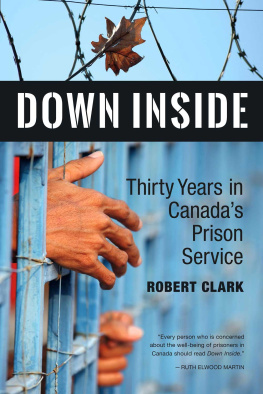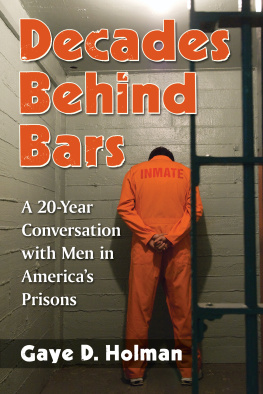INSIDE
INSIDE
Life Behind Bars in America
Michael G. Santos

St. Martins Press
New York
INSIDE: LIFE BEHIND BARS IN AMERICA . Copyright 2006 by Michael G. Santos. All rights reserved. Printed in the United States of America. No part of this book may be used or reproduced in any manner whatsoever without written permission except in the case of brief quotations embodied in critical articles or reviews. For information address St. Martins Press, 175 Fifth Avenue, New York, N.Y. 10010.
www.stmartins.com
Library of Congress Cataloging-in-Publication Data
Santos, Michael, 1964
Inside : life behind bars in America / Michael G. Santos.1st St. Martins press ed., 1st U.S. ed.
p. cm.
ISBN-13: 978-0-312-34349-1
ISBN-10: 0-312-34349-3
1. PrisonsUnited States. 2. ImprisonmentUnited States. I. Title.
HV9471.S35 2006
365'.973dc22
2006041122
First Edition: August 2006
10 9 8 7 6 5 4 3 2 1
With gratitude and loving memories
I dedicate this book to my friend, my teacher,
my mentor, Dr. R. Bruce McPherson.
He was a great man whose goodness, generosity,
and compassion I strive to emulate.
Acknowledgments
I thank God for opening all of my opportunities to grow. I thank my grandparents, my parents, my sisters, my brothers-in-law, my nieces, and my nephew. Their loving embrace eases my life, and from their support I draw strength.
I thank all of the teachers and mentors who guide me through these decades. They are friends and role models. I am grateful that each accepts me as being more than a prisoner. In particular, I thank Jon Axelrod, Tristan Axelrod, Zachary Axelrod, Peter Benekos, Tony Bisceglie, Mary Bosworth, Patricia Brieschke, Robert Brennan, Tom Cappa, Todd Clear, George Cole, Francis Cullen, John DiIulio, Seth Ferranti, Tara Gray, Colin Harris, Michael Hamden, Nichole Hinesley, Sabra Horne, Tom Jones, Nick Karis, Nancy Karis, Dennis Luther, Chris Mackey, Silvia McCollum, Carolyn McPherson, Phil McPherson, Marilyn McShane, Norval Morris, Joe Reddick, Geoffery Richstone, Maya Silva, Jonathon Solovy, Sam Torres, Howard Kieffer, Jim Sutton, Tom Tompkins, Michael Vitez, Diane Young, and Carol Zachary.
I especially thank Dr. James Schiavone, the literary agent who agreed to represent my work, and Ben Sevier, the editor at St. Martins Press who opened this publishing opportunity for me. His guidance not only strengthened this book, it makes an indelible contribution to my ongoing education. I also thank Adam Goldberger, the copy editor whose diligence and attention to detail make this book easier to read.
I thank those with whom I share space inside these boundaries. With all of the years that I have served, space does not permit a list of names. These individuals contribute to my development and understanding of lifes journey. I hope they find this work worthy of the trust they have placed in me to tell these stories we live.
Finally, with a full heart I thank my beloved wife, Carole. She is my inspiration. Her loving devotion makes all things possible in my life, and for it I pledge all of my tomorrows.
Authors Note
The characters and episodes that I describe in this book are real, although I have frequently changed their names or other identifying characteristics. I began collecting information about prison life in 1987, when my time inside began. Since then I have passed a continuous string of years in prisons of every security level. The tale of my own adjustment and efforts to reconcile with society runs through this book, but this is not one mans story. It is intended as an honest description of life in prison. I introduce readers to over one hundred characters, and through these real-life characters I hope to bring readers inside the walls of the nations correctional facilities.
To bring readers with me into this abnormal world, I describe the realities of everyday life inside, including countless crimes and violations of prison rules. I have obtained this information from the men I have lived with throughout my eighteen-plus years in prison. Some of the men are gang leaders, murderers, drug barons, and mob leaders. Still others are white-collar offenders. Many of the people I present never expect to leave prison. Others are on their way out.
While gathering information from these men in countless conversations and interviews, I described my intention to write for publication. My goals are no secret inside. This is my fourth book on various aspects of prisons, the people they hold, and strategies for growing through confinement. Just as an author cannot describe all about any culture with a single book, I write continuously to help others understand our prison system and how people proceed through it. Some men agreed to share their stories with me on condition that I do not reveal their identities; others want their stories told whether or not their identities are revealed. I remain true to the promises of confidentiality I made; consistent with those promises I provide details about my various sources of information in the endnotes section of this book.
There is a reason that my fellow prisoners speak candidly with me. I am not an outsider. I am one of them. They know that I have never sought my own release through the punishment of another. No one has ever faced a court of law or a prison disciplinary board as a consequence of anything I have said or written. And no one will ever suffer as a consequence of my work. On the contrary, I strive to illuminate the shadows in which prisoners live.
My fellow prisoners know that I do not write to alleviate my own exposure to the time I must serve. I write to help others understand this growing American subculture that prison administrators have effectively closed off from wide scrutiny. To that end I tell this story raw, without sugarcoating or holding back tough details about the prison environment. I describe the blood that I have seen spilled when acquaintances of mine have plunged knives into the flesh of others. I describe how prisoners manufacture and conceal lethal weapons. I describe the ways that people I know smuggle drugs into prisons, and how those drugs fuel an underground economy inside. Through this story readers will learn how prisoners manipulate staff into consensual sexual relationships. Ill show how some prison gang leaders use manipulation, greed, and intimidation to turn correctional officers into prostitutes. Ill provide the lurid details of prison rape.
This book brings readers into the minds of men who pass decades in cages. It strives to show the motivations and values that drive their behavior. Perhaps more important, I hope to help outside readers understand the environment that exists in these cages. With that information, readers may form conclusions on why our nation suffers from such high recidivism rates. They may grasp why relatively few prisoners manage to grow in positive ways through the adversity of the American correctional system.
Rather than using sociological jargon, I present this story in a narrative form. I base dialogue on the recollections of the participants from whom Ive heard firsthand accounts of the various stories I tell. In order to remain true to assurances about protecting identities, I have disguised certain details to protect some of my sources. Although this is a nonfiction accounting, I have used storytelling techniques to write some portions of the narrative in order to bring audiences inside with me; I detail instances in which Ive used these techniques in the endnotes section of the book.













